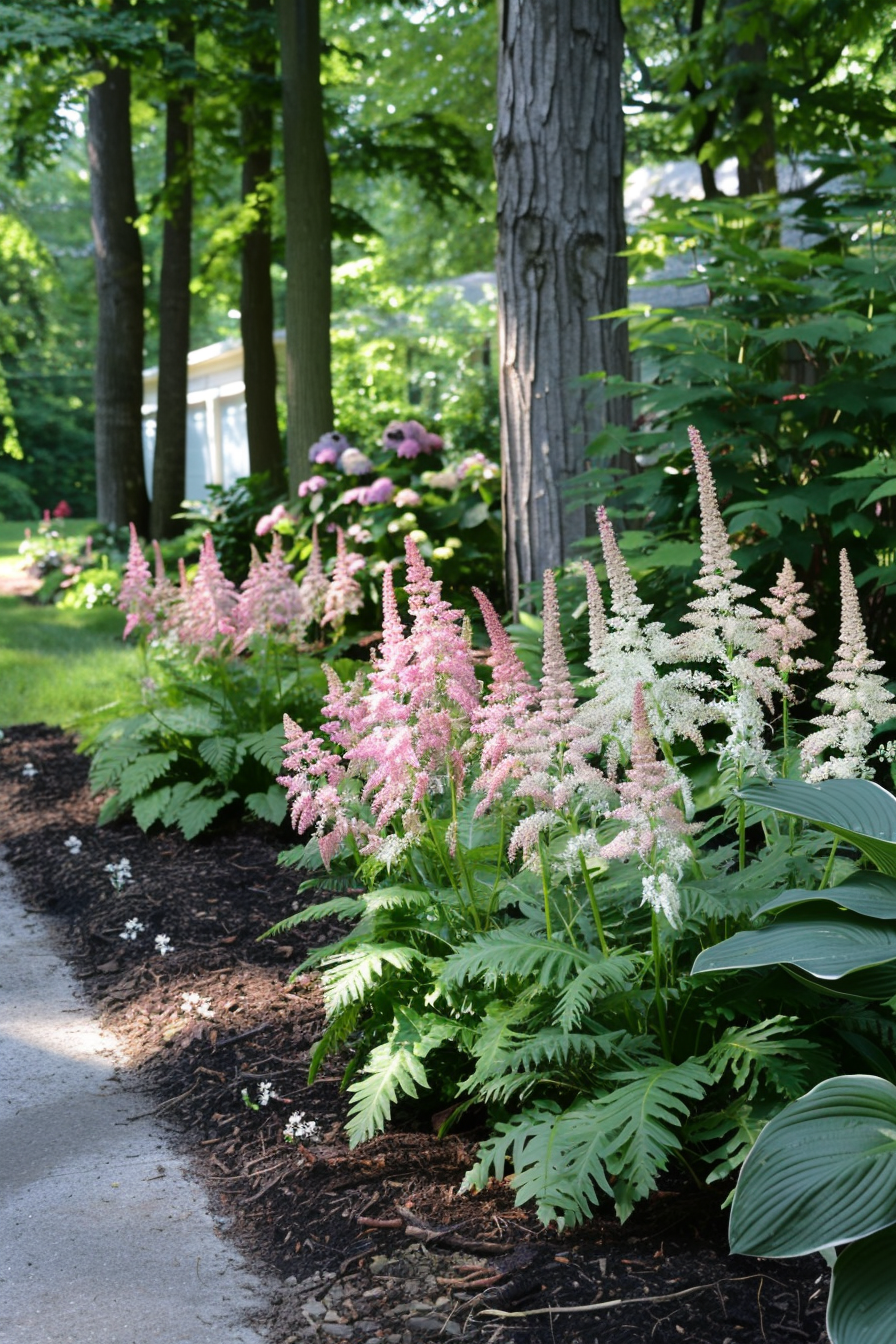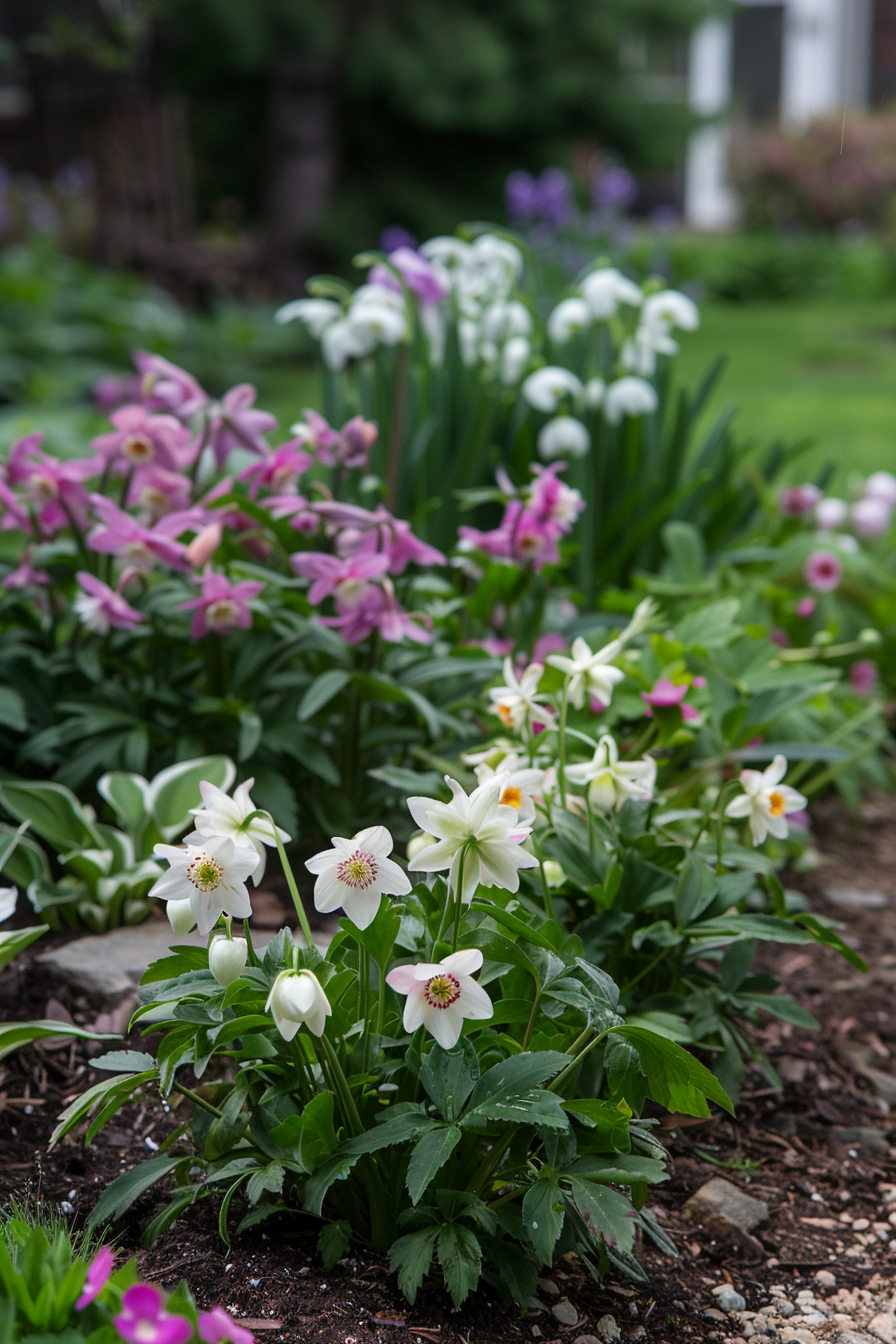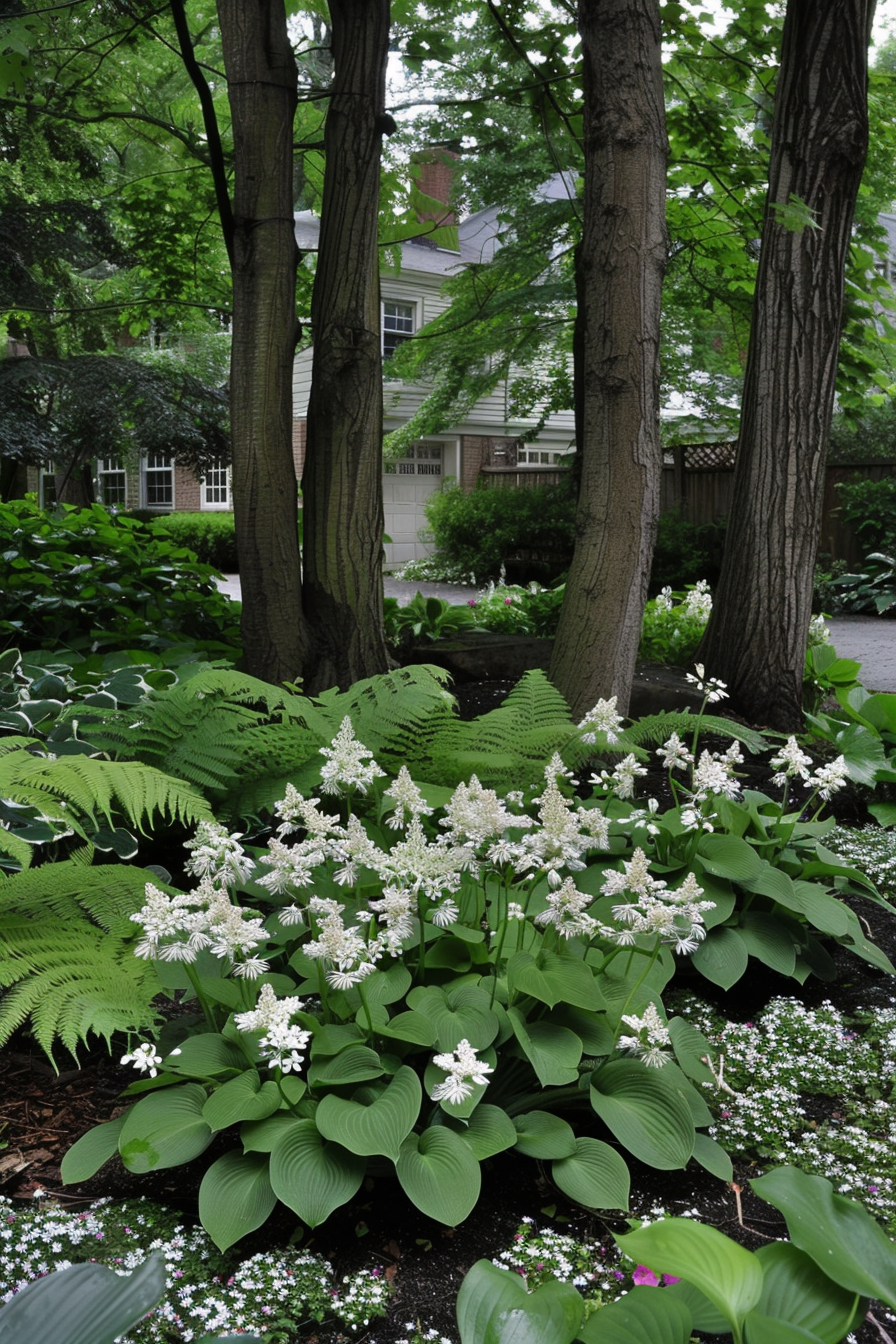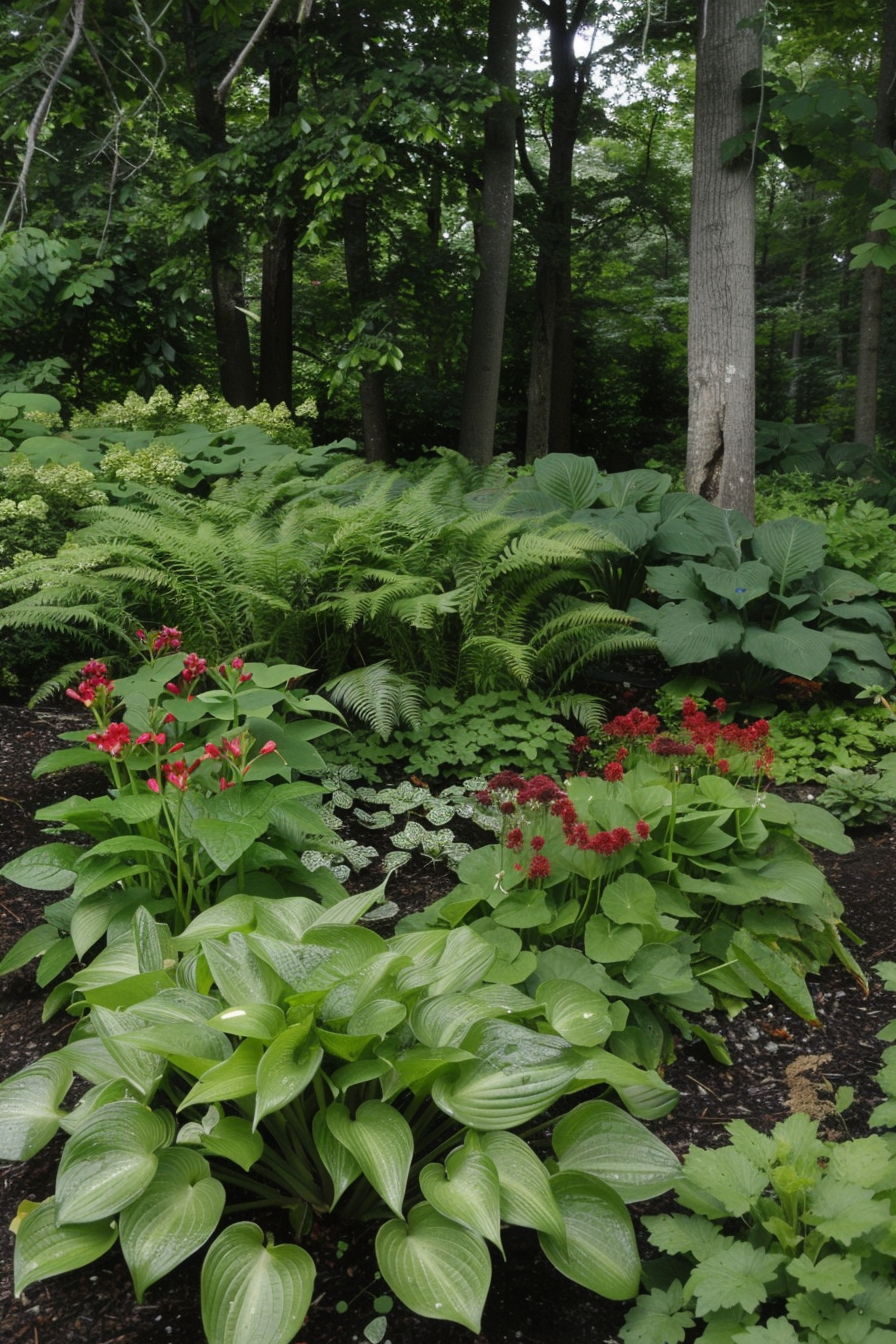How to Choose Shade-Loving Plants for Your Front Yard
Did you know that some of the most vibrant gardens thrive in the shade? Your front yard doesn’t need to bask in sunlight all day to be a showstopper. In fact, shade-loving plants can transform those dim corners into a lush, serene oasis. Let’s dive into how you can make the most of your shady spaces with plants that love the low-light life.
How to Start with a Shady Front Yard?
Shade isn’t a setback—it’s an opportunity to create a cool, calming retreat right at your doorstep.
- Diverse Plant Selection: From the broad leaves of hostas to the delicate blooms of bleeding hearts, shade-loving plants offer a rich variety.
- Texture and Foliage: Focus on plants with interesting leaves and textures since flowers might be less frequent.
- Layering Plants: Create depth by layering plants of different heights and forms.
Must-Have Shade-Loving Plants
Ready to get your hands dirty? Here are some shade superstars to consider:
- Hostas: Known for their stunning foliage, hostas come in hues from deep blue-green to bright gold. They’re the perfect backdrop for other plants.
- Ferns: Add a touch of elegance with ferns like the Japanese painted fern, which brings unique color and texture.
- Astilbes: With fluffy, plume-like flowers, astilbes introduce pinks, reds, and whites into your garden.
- Heucheras (Coral Bells): These perennials offer vibrant foliage in shades of purple, caramel, and lime green.
- Bleeding Hearts: Their heart-shaped pink and white flowers add a romantic touch.
Tips to Achieve a Stunning Shady Garden
Transforming your front yard is easier than you think! Here are some pointers to get you started:
- Understand Your Shade: Is it full shade or partial shade? Knowing this helps you pick the right plants.
- Soil Matters: Enrich your soil with compost to provide nutrients and improve drainage.
- Layering Is Key: Plant taller shrubs like hydrangeas at the back, mid-sized plants in the middle, and ground covers like ivy at the front.
- Incorporate Different Textures: Mix plants with varying leaf sizes and shapes to add visual interest.
- Don’t Forget Color: Use shade-tolerant flowering plants to add splashes of color—think impatiens and begonias.
- Add Hardscape Elements: Paths, rocks, and garden ornaments can enhance the aesthetic and make your garden uniquely yours.
Budget-Friendly and DIY Ideas
Gardening on a budget? No problem!
- Seed Swaps: Join local gardening clubs to exchange seeds and cuttings (it’s fun and free!).
- DIY Garden Decor: Create your own stepping stones or garden markers for a personal touch.
- Repurpose Materials: Use old bricks or stones to build borders or pathways.
- Compost at Home: Turn kitchen scraps into nutrient-rich compost.
- Shop Smart: Visit nurseries at the end of the season for discounted plants and supplies.
Global Inspirations to Spice Up Your Garden
Take cues from gardens around the world:
- Japanese Shade Gardens: Incorporate elements like bamboo, stone lanterns, and water features for a peaceful retreat.
- English Cottage Gardens: Embrace a wild, natural look with foxgloves, ferns, and climbing vines.
- Tropical Vibes: Use large-leafed plants like elephant ears to create a lush atmosphere.
If You Take Away Nothing Else, Then…
- Mulch, Mulch, Mulch: It retains moisture and suppresses weeds—your plants will thank you!
- Water Wisely: Even shade plants need water. Aim for a deep watering once a week.
- Stay Consistent with Themes: Whether it’s color schemes or garden styles, consistency creates harmony.
- Accessorize Thoughtfully: A well-placed bench or birdbath can become a focal point.
- Be Patient: Gardens take time to mature. Enjoy the process and celebrate small victories along the way.
1. Astilbe (Astilbe spp. – False Spirea)

Astilbe is a standout choice for shady spots in your front yard. Known for its feathery plumes of flowers that rise above delicate, fern-like foliage, Astilbe adds a touch of elegance and vertical interest to any garden. Available in a spectrum of colors from soft whites and pinks to vibrant reds and purples, these plants bloom in early summer, providing a long-lasting display that is both eye-catching and sophisticated.
Astilbe thrives in consistently moist, well-drained soil, making it an ideal companion for other shade-loving plants that enjoy similar conditions. When planted in groups, they create a lush, meadow-like effect that is perfect for softening the edges of pathways or framing entryways. Their tolerance to partial to full shade makes them versatile and easy to integrate into various garden designs.
To create a captivating front yard scene, plant Astilbe alongside ferns and hostas for a rich tapestry of textures and colors. This combination will not only highlight the delicate beauty of the Astilbe but also provide a stunning contrast with the broader leaves of hostas and the fine, airy fronds of ferns.

2. Bleeding Heart (Dicentra spectabilis)

Bleeding Heart is a classic perennial that brings a touch of romantic charm to shaded front yards. With its graceful, arching stems adorned with heart-shaped flowers that dangle like delicate pendants, this plant is a true delight in the spring garden. The flowers come in shades of pink, white, and red, and they contrast beautifully with the plant’s soft, fern-like foliage.
This plant flourishes in rich, well-drained soil and prefers cool, shady conditions, making it perfect for planting under trees or along north-facing walls. Bleeding Heart pairs beautifully with other early spring bloomers like violets and lungworts, creating a layered effect that evolves as the season progresses. After its flowering period, Bleeding Heart will go dormant in the heat of summer, so consider planting it alongside late-blooming perennials to maintain garden interest.
Enhance the whimsical allure of Bleeding Heart in your landscape by planting it in a shaded border or as a focal point in a woodland-style garden. The interplay of its delicate flowers with lush, leafy companions will create a serene and enchanting outdoor space.

3. Coral Bells (Heuchera spp.)

Coral Bells are renowned for their vibrant foliage, which comes in an array of colors from deep purples and burgundies to bright greens and silver. These shade-tolerant perennials add year-round interest to the garden with their striking, ruffled leaves and delicate flower spikes that rise above the foliage in late spring and summer.
Ideal for edging pathways, borders, or as ground cover, Coral Bells thrive in well-drained soil and can tolerate a variety of light conditions, though they perform best in partial shade. They are particularly effective in adding color and texture to shaded areas where other plants may struggle to thrive. Pair them with other shade-loving perennials like hostas and ferns to create a dynamic and colorful garden palette.
Incorporate Coral Bells into your front yard to create a vibrant and textured landscape. Their varied leaf colors provide a beautiful contrast to more traditional green foliage, and their low maintenance needs make them a practical choice for busy gardeners.

4. Trillium (Trillium spp.)

Trillium, also known as Wake Robin or Wood Lily, is a treasured native wildflower that brings understated beauty to shaded gardens. Recognized by their three-petaled flowers that sit atop a whorl of three leaves, Trilliums are a symbol of spring and are often found carpeting the forest floor. Their flowers can be white, pink, red, or even yellow, depending on the species.
These perennials thrive in rich, humus-rich soil and prefer cool, moist conditions, making them perfect for planting under trees or in woodland gardens. Trilliums are slow to establish but are worth the wait for their elegant blooms and the naturalistic look they bring to the garden. Pair them with ferns and other woodland plants for a serene and cohesive design.
Trilliums add a touch of natural beauty to shaded front yards, creating a peaceful and enchanting space. Their unique floral structure and quiet elegance make them ideal for gardeners who appreciate subtlety and the charm of native plants.

5. Lenten Rose (Helleborus spp.)

Lenten Rose, or Hellebore, is a shade-loving perennial that blooms in late winter to early spring, often when little else is in flower. Known for its nodding, cup-shaped blooms in a range of colors including white, pink, purple, and green, Hellebore adds a splash of color to the garden during the colder months. Its leathery, evergreen foliage provides year-round interest and makes it a reliable addition to any shaded garden.
Hellebores thrive in well-drained soil rich in organic matter and prefer partial to full shade. They are particularly effective when planted in groups under deciduous trees, where their early blooms can be enjoyed before the tree canopy fills in. Pair them with other early spring bloomers like snowdrops or violets to create a dynamic and colorful display.
Bring a touch of winter beauty to your front yard by incorporating Lenten Roses into your landscape. Their early blooms and evergreen foliage will brighten up even the shadiest spots, providing a welcome burst of color and life during the cooler months.

6. Foamflower (Tiarella cordifolia)

Foamflower is a charming shade-loving perennial known for its frothy, star-shaped blooms that appear in spring atop mounds of heart-shaped, deeply lobed leaves. The flowers are typically white or pink and rise above the foliage on delicate stems, creating a soft, cloud-like effect in the garden. The foliage is also attractive, often featuring dark veins that provide a striking contrast against the lighter leaf surface.
This plant thrives in moist, well-drained soil and prefers partial to full shade. Foamflower is an excellent ground cover for shaded areas, spreading gently by runners to create a lush, carpet-like appearance. It pairs beautifully with other woodland plants such as ferns and hostas, adding texture and lightness to the garden.
Enhance the natural beauty of your shaded front yard by planting Foamflower in drifts under trees or along shady borders. Its delicate blooms and attractive foliage will create a peaceful and inviting atmosphere, perfect for enjoying the tranquility of a shaded garden.

7. Foxglove (Digitalis purpurea)

Foxglove is a striking biennial known for its tall spires of tubular flowers that rise majestically above rosettes of large, green leaves. These flowers, often in shades of purple, pink, white, and yellow, are beloved by bees and add a dramatic vertical element to shaded gardens. Foxglove thrives in partial shade and moist, well-drained soil, making it ideal for planting along the edges of wooded areas or in mixed borders.
Foxglove is particularly effective when planted in drifts or naturalized in shaded areas, where its tall flower spikes can provide a stunning focal point. It pairs well with other cottage garden favorites like columbine and lungwort, creating a lush, layered effect that attracts pollinators and adds visual interest throughout the growing season.
Introduce Foxglove to your shaded front yard to enjoy its towering blooms and the charm it brings to the garden. Its bold flowers and graceful form will create a striking contrast with lower-growing shade plants and add a sense of drama to your landscape.

8. Violet (Viola spp.)

Violets are delightful, low-growing perennials that bring a splash of color to shaded gardens with their delicate, heart-shaped leaves and vibrant flowers. Blooming in early spring, Violets come in a range of colors including purple, blue, white, and yellow. They are easy to grow and can naturalize quickly, creating a carpet of blooms that brighten up even the darkest corners of the garden.
These charming flowers thrive in moist, well-drained soil and prefer partial to full shade. They are perfect for planting under trees, along shaded borders, or in woodland gardens where they can spread freely. Violets are also excellent companions for other early spring bloomers like trilliums and lungworts, adding layers of color and interest to the garden.
Create a whimsical and colorful front yard by incorporating Violets into your shaded landscape. Their cheerful blooms and low maintenance needs make them a delightful addition to any garden, providing early spring color and a touch of nostalgia.

9. Lungwort (Pulmonaria spp.)

Lungwort is a versatile perennial known for its attractive, speckled foliage and clusters of tubular flowers that change color as they age. Typically blooming in shades of blue, pink, or white, Lungwort flowers bring early spring color to shaded gardens and are a favorite of pollinators. The foliage, often variegated with silver or white spots, provides year-round interest and makes Lungwort a valuable ground cover for shaded areas.
This plant thrives in moist, well-drained soil and prefers partial to full shade. Lungwort is particularly effective when planted in drifts under trees or in shady borders, where its colorful blooms and striking foliage can shine. It pairs well with other shade-loving perennials like hostas and ferns, creating a rich tapestry of textures and colors.
Enhance the visual appeal of your shaded front yard by planting Lungwort alongside other perennials with contrasting foliage. Its early blooms and distinctive leaves will add a touch of elegance and interest to your garden throughout the year.

10. Impatiens (Impatiens spp.)

Impatiens are a classic choice for adding vibrant color to shaded areas. These shade-loving annuals are known for their prolific blooms in a wide range of colors, including red, pink, orange, purple, and white. Impatiens thrive in moist, well-drained soil and prefer partial to full shade, making them ideal for planting in containers, hanging baskets, or as ground cover in shaded borders.
These cheerful flowers are easy to grow and maintain, making them perfect for adding instant color to any garden. They pair well with other shade-loving annuals and perennials, creating a lush, vibrant display that brightens up even the darkest corners. Plant Impatiens in mass plantings or intersperse them among other plants to create a tapestry of color and texture.
Transform your shaded front yard into a colorful oasis by planting Impatiens in borders, containers, or hanging baskets. Their bright blooms and compact growth habit make them a versatile and eye-catching addition to any garden.

11. Hosta (Hosta spp.)

Hostas are beloved for their large, lush foliage and are a staple in shade gardens. With leaves ranging from deep green to variegated patterns of green, yellow, and white, Hostas add texture and visual interest to any garden. They also produce tall flower spikes with delicate, bell-shaped blooms in the summer, though their primary appeal is their striking foliage.
These perennials thrive in rich, well-drained soil and prefer partial to full shade, making them ideal for planting under trees, along shaded pathways, or in mixed borders. Hostas are available in a variety of sizes and forms, allowing for endless design possibilities. They pair beautifully with other shade-loving plants like ferns and Coral Bells, creating a lush, layered look.
Incorporate Hostas into your shaded front yard to create a lush, green haven. Their bold leaves and easy care requirements make them a perfect choice for adding structure and interest to shaded areas.

12. Japanese Painted Fern (Athyrium niponicum)

Japanese Painted Fern is a striking fern that brings a touch of elegance and color to shaded gardens. Known for its fronds that are painted with shades of silver, purple, and green, this fern adds a unique and eye-catching element to any landscape. Its delicate, lacy foliage provides a soft texture that contrasts beautifully with the bold leaves of hostas and other shade-loving perennials.
This fern thrives in moist, well-drained soil and prefers partial to full shade. Japanese Painted Fern is an excellent choice for planting in shaded borders, woodland gardens, or as a ground cover under trees. It pairs well with other ferns and shade-loving plants, creating a cohesive and visually appealing garden design.
Enhance the beauty of your shaded front yard by incorporating Japanese Painted Fern into your landscape. Its unique coloration and delicate form will add a touch of elegance and sophistication to any shaded area.

13. Western Sword Fern (Polystichum munitum)

Western Sword Fern is a robust and versatile fern that adds a touch of evergreen beauty to shaded gardens. Known for its long, arching fronds that can reach up to four feet in length, this fern provides a dramatic and lush backdrop in any landscape. Its dark green foliage remains attractive throughout the year, making it a reliable choice for adding structure and texture to shaded areas.
This fern thrives in moist, well-drained soil and prefers partial to full shade. Western Sword Fern is perfect for planting in woodland gardens, shaded borders, or as a ground cover under trees. It pairs well with other shade-loving perennials like hostas and ferns, creating a rich, layered look that is both natural and elegant.
Incorporate Western Sword Fern into your shaded front yard to enjoy its bold, evergreen fronds and the lush, tropical feel it brings to the garden. Its robust growth and low maintenance needs make it a valuable addition to any shaded landscape.

14. Autumn Fern (Dryopteris erythrosora)

Autumn Fern is a beautiful shade-loving fern known for its vibrant new fronds that emerge in shades of coppery red and gradually mature to deep green. This fern adds a splash of color to the garden throughout the growing season and is particularly striking in spring and fall. Its arching, lance-shaped fronds provide a soft texture that complements the bold leaves of other shade plants.
This fern thrives in moist, well-drained soil and prefers partial to full shade. Autumn Fern is ideal for planting in shaded borders, woodland gardens, or as a ground cover under trees. It pairs well with other ferns and shade-loving perennials, creating a cohesive and visually appealing garden design.
Bring a touch of seasonal color to your shaded front yard by planting Autumn Fern. Its vibrant fronds and elegant form will add interest and beauty to your garden throughout the year.

15. Wild Ginger (Asarum canadense)

Wild Ginger is a charming, low-growing perennial that adds a touch of elegance to shaded gardens with its heart-shaped leaves and hidden, cup-shaped flowers. The foliage is a rich, deep green and often forms a dense, ground-covering mat that provides excellent weed suppression. The small, maroon flowers are usually tucked beneath the leaves, adding a touch of mystery and intrigue to this plant.
This perennial thrives in moist, well-drained soil and prefers partial to full shade. Wild Ginger is perfect for planting in woodland gardens, shaded borders, or as a ground cover under trees. It pairs well with other shade-loving plants like ferns and hostas, creating a lush, cohesive look in the garden.
Enhance the natural beauty of your shaded front yard by planting Wild Ginger. Its dense foliage and hidden blooms will add a touch of mystery and elegance to your garden, creating a peaceful and inviting space.






